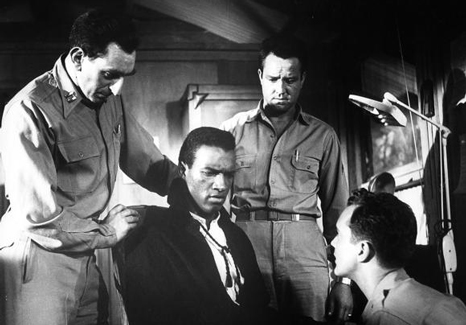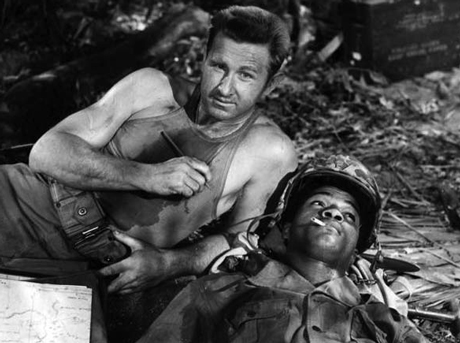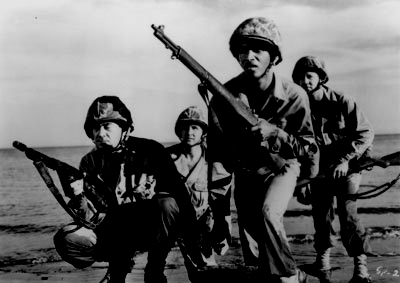|
|
Reviewed by Glenn Erickson
The socially progressive movies of the early postwar years were a serious movement, not a fad. Sam Goldwyn's prestigious production The Best Years of Our Lives (1946) offered a realistic view of the harsh welcome extended to returning veterans, and its success encouraged a brief burst of issue-related pictures, until the movement was silenced by the blacklist. Producers Walter Wanger and Darryl F. Zanuck had been associated with subject matter considered politically leftist before the war. Among others, they were joined by Louis de Rochemont (Lost Boundaries) (1949) and Robert Stillman (Try and Get Me!) (1950) in making controversial movies with the overt purpose of raising public awareness. In his position as a studio production head, Zanuck did his best to protect 'suspect' writers and directors from the blacklist.
Back in the 1940s it was an act of courage for a movie to criticize the American status quo, or to tell the truth about deplorable social inequities. The Mervyn LeRoy-Albert Maltz-Frank Sinatra short subject The House I Live In (1945) was a simple plea for religious tolerance, yet it caused a minor conservative uproar. Elia Kazan's Gentleman's Agreement seems rather self-important now, but in 1947 a movie targeting anti-Semitism was a very big deal. Of course, most of these films were as commercially oriented as any Hollywood product. Producers claimed to be telling the whole truth even as their films made significant compromises in search of a wide audience. The murder victim in the breakthrough thriller Crossfire (1947) was originally written as a homosexual, but the existence of gays was too much for the Production Code so the victim became a Jew.
A producer who frequently characterized himself as a brave pioneer tackling the tough subjects was Stanley Kramer. Kramer tried a number of genres, coming up with worthy non-hits (Member of the Wedding (1952), The 5,000 Fingers of Dr. T (1953)) but also a few popular winners (High Noon (1952), The Wild One (1953)). To Kramer, really powerful drama always meant controversy. His earlier shows included an unusual story about handicapped war veteran, and a pre- Psycho thriller about a deranged serial killer. Almost every one of Kramer's later films would address a 'big issue': medical ethics, race prejudice, nuclear war, the Scopes 'monkey trial', and so forth. Unkind reviewers remarked that his pictures oversimplified complex problems for public consumption.

From the very beginning, Stanley Kramer promoted the idea that he and his creative collaborators were demonstrating great moral courage by daring to tell an important truth. For his third production, Kramer asked his close writing associate Carl Foreman to adapt a 1946 stage play by Arthur Laurents. Home of the Brave (1949). Laurents' 'problem minority' character was Jewish, but the film adaptation makes him an African-American. Arthur Laurents said that when he asked about the change, Kramer replied, "Jews have been done." Kramer wanted to 'blow the lid off the race issue', not revisit Gentleman's Agreement. Although the shift of the central character from Jewish to black fares more smoothly in some respects than it does in others, the film is now considered the archetype of a socially conscious issue film.
In the South Pacific of 1944, an army doctor (Jeff Corey) has only a couple of days to shake Private Peter Moss (James Edwards) out of a psychosomatic inability to walk. Moss just returned from a near-suicide mission to survey a Japanese-held island. The mission leader was young Major Robinson (Douglas Dick), and in flashbacks we meet Moss's fellow volunteers Finch (Lloyd Bridges), Sergeant Mingo (Frank Lovejoy) and T.J. Everett (Steve Brodie), all of whom are white. Mingo isn't bothered by Moss's skin color, and Finch and Moss were best pals in high school. But T.J. Everett is a bigot. He initially thinks that serving alongside a black will be impossible, and when they get to the island his caustic remarks about Moss's color put the mission on edge. After Finch lets slip a prejudicial comment as well, Moss's hopes for group acceptance vanish. Japanese snipers complicate the team's withdrawal. Unable to save the one comrade he still trusts, Moss gets the notion that he is a coward, and loses the ability to use his legs.
The smartly conceived Home of the Brave combines themes of combat, race prejudice and psychology. Director Mark Robson and screenwriter Carl Foreman were fresh from Kramer's previous hit Champion (1949). Except for some stock footage and a scene shot on a Malibu beach, the entire picture was filmed on modest interior sets. Dimitri Tiomkin's busy orchestral score evokes a feeling of a much bigger production.

Robson's direction and the well-chosen cast make Laurents' play feel concentrated instead of claustrophobic. Douglas Dick's Major Robinson thinks at first that a mistake has been made with Moss, but his commanding officer straightens him out: "What color is he? I don't care if he's purple. We need him for this mission." Lloyd Bridges is hale 'n' hearty as Finch. As we see in another flashback, Finch tried to be a good pal to Peter Moss back in school, extending an invitation to a post-graduation party that Moss couldn't/wouldn't attend. Good actor Steve Brodie is most noted for playing unreliable or treacherous characters in films noir like Out of the Past (1947). Brodie's T.J. is an unusually credible racist in that he's ignorantly unaware that his 'harmless' jokes and comments give offense. Frank Lovejoy's levelheaded Sergeant Mingo is alone among the group in simply accepting Moss for what he is, another soldier doing his job. The film's stage origins do show through on occasion. Stuck in a high-pressure situation on an enemy island, Mingo takes time out to recite poetry.
The talented James Edwards was a true Hollywood barrier breaker several years before the arrival of Sidney Poitier. Unlike most every other black film actor of the late '40s, Edwards seldom played servants or African natives. He instead had standout roles in pictures as diverse as Member of the Wedding, The Phenix City Story (1955), The Killing (1956), The Manchurian Candidate (1962) and The Sandpiper (1965). Edwards' Private Peter Moss is a solid underdog, and an optimist willing to earn his position in the special unit. The screenplay doesn't position him as a hero, military or moral. In the high school flashback he already seems to be questioning why his buddy Finch is being so friendly. Under the stress of the mission, he is quick to resent T.J. and Finch's racial slurs.
The racial tension makes itself felt as soon as Private Moss appears, and the stressful mission brings it out into the open. The word 'nigger' hadn't been allowed in American movies since the Production Code came in, and its return in a widely distributed film was surely a surprise to audiences. Had the show simply charted a case of white-on-black prejudice it might have had only a sensational, perhaps exploitative impact. But Home of the Brave gives Moss a much more complicated reaction. Although it may now seem like something from a '50s live TV drama, Moss's psychological trauma, converting his feelings of low self-esteem into a physical impairment, is the best part of the movie. James Edwards fully expresses Moss's anguish, and his interplay with Jeff Corey's highly motivated medic is exemplary. The 'new' psychology was a popular theme in '40s pictures, and Home of the Brave uses it to make an important statement: racial prejudice is a society-wide mental illness stemming from ignorance and insecurity.

The changing of Moss from a Jew to a black puts a strain on the show's credibility, mainly because the issues with the two minorities are not really interchangeable. The film's high school flashback seems forced, and false. Moss is uncomfortable around Finch for subtle reasons, when everyone on campus including Finch would surely be aware that a white student associating with a black student would at best be considered socially 'uncomfortable'. Even if Moss were a star athlete, it might not have made much of a difference. 1
The "hard hitting" movie also soft-pedals the facts about racial segregation in WW2. Carl Foreman's script implies that Major Robinson is assigned a black surveyor due to a lack of manpower. This would seem an extraordinary circumstance. There were obviously qualified black engineers and surveyors in the 1940s, but the entire wartime Army was completely segregated. Most black combat units were 'held in reserve', and instead assigned to duties like driving trucks. President Truman didn't integrate the armed services until 1948. In his autobiography, Arthur Laurents noted that not a single critic pointed out what any veteran would recognize as a glaring misrepresentation. The film pretends that official racism in the armed forces had never existed, sweeping the issue under the rug. Does this put producer Kramer's liberal commitment in question, or is it just another example of an unavoidable Hollywood compromise?
In general, the racial animus expressed in Home of the Brave would seem to be grossly understated. A quick read of Studs Terkel's book The Good War gives the impression that race hatred in the U.S. Army was so intense that many white soldiers considered blacks as much the enemy as the Germans or Japanese. It's much more likely that even the fair-minded Sergeant Mingo would reject Moss, as an unnecessary complication to a job that was tough enough already. A black audience of 1949 might reject the Peter Moss character as well, for the reason that he has supposedly lived in America for twenty years yet seems unrealistically unaware of the scope and depth of race hatred. In general, African-American audiences had little use for most of Hollywood's 'social issue' films about black America.
The story made much better sense as Arthur Laurents wrote it. Anti-Semitic hatred isn't any less vicious, but bigots first have to identify their target for abuse through something less obvious than skin color. American Jews surely endured their share of discrimination in the armed forces, but they were allowed to serve throughout the services and were considered equals in the military hierarchy. It is far more credible that a Jewish soldier with an optimistic attitude might undergo a gradual disillusionment and crisis of self-doubt such as is seen in Home of the Brave. Arthur Laurents named his Jewish private Peter Coen, nicknamed 'Coney'. We can imagine Pete Coen trying not to hurt Finch's feelings as he makes excuses for not attending a party where he wouldn't be made welcome. And we can better imagine Pete Coen eager to be part of an important stealth mission, only to endure psychological strain when he realizes that he's not going to be accepted there either. All it takes to ruin mission solidarity is one mouthy bigot like T.J..

Through clever promotion and marketing Stanley Kramer made the impressive Home of the Brave into a mini- cause cèlébre. Arthur Laurents' play had closed in New York after just a couple of weeks, but the movie has long been touted as a milestone for race-related filmmaking. Its creative contributors certainly felt the political backlash of the right wing -- Jeff Corey and Carl Foreman were blacklisted and Lloyd Bridges had his own close scrape with the committees. Frank Lovejoy seems to have come out of this period unscathed, but his filmography takes an abrupt turn to the right just a few films later. After appearing in Cy Endfield's socially critical Try and Get Me!, Lovejoy starred in the hysterical anti-Red thriller I Was a Communist for the FBI (1951), and was suddenly typed as a specialist in salute-the-flag soldiers and cops.
Producer Stanley Kramer eventually took an aggressive and outspoken attitude toward the Hollywood blacklist. When asked why he hired a 'tainted' writer for his The Defiant Ones, Kramer retorted that America was a free country and he'd not let anyone tell him who he could and could not hire. This left his ideological adversary Ronald Reagan to back-pedal, claiming that blacklisted writers were targeted not for their scripts, but for their agitation in labor guilds. Mr. Kramer wore the label "nervy liberal" with pride.

Olive Films' disc of Home of the Brave is another Blu-ray of a Stanley Kramer production originally released through United Artists. It once showed on TV fairly frequently but disappeared in the 1970s. The film elements appear to be in excellent condition. Cinematographer Robert De Grasse's classy B&W images often make us forget that we're mostly looking at a studio-concocted island jungle set. The bold music score by Dimitri Tiomkin expands the film's canvas, pulling in plenty of quotes from other bits of music. Home of the Brave remains one of the most adventurous race-equality issue films of the late 1940s.
On a scale of Excellent, Good, Fair, and Poor,
Home of the Brave Blu-ray rates:
Movie: Very Good
Video: Excellent
Sound: Excellent
Audio: English
Supplements: none
Deaf and Hearing Impaired Friendly?
No; Subtitles: None
Packaging: Keep case
Reviewed: May 20, 2014
Republished by permission of Turner Classic Movies.
Footnotes:
1. It sure didn't in my high school, even in 1968.
Return

Text © Copyright 2014 Glenn Erickson
See more exclusive reviews on the Savant Main Page.
Reviews on the Savant main site have additional credits information and are often updated and annotated with footnotes, reader input and graphics.
Return to Top of Page
|

